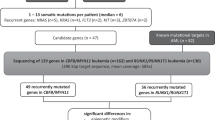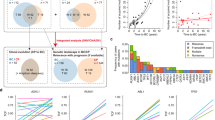Abstract
The CCAAT/enhancer-binding protein-alpha (CEBPA) is a transcription factor strongly implicated in myelopoiesis through control of proliferation and differentiation of myeloid progenitors. Recently, several works have reported the presence of CEBPA-acquired mutations in hematological malignancies. In this work, we analyzed characteristics of mutations and their correlation with disease characteristics described in previous studies. In the 1175 patients reported, 146 CEBPA mutations were identified in 96 patients. Mutations were found in the whole gene sequence, but cluster regions were clearly identified. Furthermore, two categories of mutations were reported: out-of-frame ins/del often in the N-terminal region, and in-frame ins/del often in the C-terminal region. CEBPA mutations were reported exclusively in acute myeloid leukemia (AML) (according to WHO classification criteria) and mutated patients preferentially belonged to M1, M2 and M4 FAB subtypes. All but one case belonged to the ‘intermediate’ prognostic subgroup of MRC classification. In the absence of poor prognostic factors, patients with CEBPA mutation had favorable outcome, very similar to that of the t(8;21), inv(16), t(15;17) subgroup. Systematic analysis of CEBPA mutations, in addition to that of alterations in master genes of hematopoiesis, may be useful to assess the prognosis of AML particularly in patients belonging to the ‘intermediate’ prognostic subgroup.
This is a preview of subscription content, access via your institution
Access options
Subscribe to this journal
Receive 12 print issues and online access
$259.00 per year
only $21.58 per issue
Buy this article
- Purchase on Springer Link
- Instant access to full article PDF
Prices may be subject to local taxes which are calculated during checkout

Similar content being viewed by others
References
Tenen DG . Disruption of differentiation in human cancer: AML shows the way. Nat Rev Cancer 2003; 3: 89–101.
Roumier C, Fenaux P, Lafage M, Imbert M, Eclache V, Preudhomme C . New mechanisms of AML1 gene alteration in hematological malignancies. Leukemia 2003; 17: 9–16.
Pabst T, Mueller BU, Zhang P, Radomska HS, Narravula S, Schnittger S et al. Dominant-negative mutations of CEBPA, encoding CCAAT/enhancer binding protein-alpha (C/EBPalpha), in acute myeloid leukemia. Nat Genet 2001; 27: 263–270.
Tenen DG, Hromas R, Licht JD, Zhang DE . Transcription factors, normal myeloid development, and leukemia. Blood 1997; 90: 489–519.
Reddy VA, Iwama A, Iotzova G, Schulz M, Elsasser A, Vangala RK et al. Granulocyte inducer C/EBPalpha inactivates the myeloid master regulator PU.1: possible role in lineage commitment decisions. Blood 2002; 100: 483–490.
Zhang P, Nelson E, Radomska HS, Iwasaki-Arai J, Akashi K, Friedman AD et al Induction of granulocytic differentiation by 2 pathways. Blood 2002; 99: 4406–4412.
Keeshan K, Santilli G, Corradini F, Perrotti D, Calabretta B . Transcription activation function of C/EBPalpha is required for induction of granulocytic differentiation. Blood 2003; 102: 1267–1275.
Radomska HS, Huettner CS, Zhang P, Cheng T, Scadden DT, Tenen DG . CCAAT/enhancer binding protein alpha is a regulatory switch sufficient for induction of granulocytic development from bipotential myeloid progenitors. Mol Cell Biol 1998; 18: 4301–4314.
Johansen LM, Iwama A, Lodie TA, Sasaki K, Felsher DW, Golub TR et al. c-Myc is a critical target for c/EBPalpha in granulopoiesis. Mol Cell Biol 2001; 21: 3789–3806.
Smith LT, Hohaus S, Gonzalez DA, Dziennis SE, Tenen DG . PU.1 (Spi-1) and C/EBP alpha regulate the granulocyte colony-stimulating factor receptor promoter in myeloid cells. Blood 1996; 88: 1234–1247.
Klempt M, Melkonyan H, Hofmann HA, Eue I, Sorg C . The transcription factors c-myb and C/EBP alpha regulate the monocytic/myeloic gene MRP14. Immunobiology 1998; 199: 148–151.
D'Alo F, Johansen LM, Nelson EA, Radomska HS, Evans EK, Zhang P et al. The amino terminal and E2F interaction domains are critical for C/EBP alpha-mediated induction of granulopoietic development of hematopoietic cells. Blood 2003; 102: 3163–3171.
Wang QF, Cleaves R, Kummalue T, Nerlov C, Friedman AD . Cell cycle inhibition mediated by the outer surface of the C/EBPalpha basic region is required but not sufficient for granulopoiesis. Oncogene 2003; 22: 2548–2557.
Timchenko NA, Wilde M, Nakanishi M, Smith JR, Darlington GJ . CCAAT/enhancer-binding protein alpha (C/EBP alpha) inhibits cell proliferation through the p21 (WAF-1/CIP-1/SDI-1) protein. Genes Dev 1996; 10: 804–815.
Zhang DE, Zhang P, Wang ND, Hetherington CJ, Darlington GJ, Tenen DG . Absence of granulocyte colony-stimulating factor signaling and neutrophil development in CCAAT enhancer binding protein alpha-deficient mice. Proc Natl Acad Sci USA 1997; 94: 569–574.
Friedman AD . Transcriptional regulation of granulocyte and monocyte development. Oncogene 2002; 21: 3377–3390.
Bennett JM, Catovsky D, Daniel MT, Flandrin G, Galton DA, Gralnick HR et al. Proposals for the classification of the acute leukaemias. French–American–British (FAB) co-operative group. Br J Haematol 1976; 33: 451–458.
Pabst T, Mueller BU, Harakawa N, Schoch C, Haferlach T, Behre G et al. AML1-ETO downregulates the granulocytic differentiation factor C/EBPalpha in t(8;21) myeloid leukemia. Nat Med 2001; 7: 444–451.
Perrotti D, Cesi V, Trotta R, Guerzoni C, Santilli G, Campbell K et al. BCR-ABL suppresses C/EBPalpha expression through inhibitory action of hnRNP E2. Nat Genet 2002; 30: 48–58.
Nerlov C . C/EBPalpha mutations in acute myeloid leukaemias. Nat Rev Cancer 2004; 4: 394–400.
Snaddon J, Smith ML, Neat M, Cambal-Parrales M, Dixon-McIver A, Arch R et al. Mutations of CEBPA in acute myeloid leukemia FAB types M1 and M2. Genes Chromosomes Cancer 2003; 37: 72–78.
van Waalwijk van Doorn-Khosrovani SB, Erpelinck C, Meijer J, van Oosterhoud S, van Putten WL, Valk PJ et al. Biallelic mutations in the CEBPA gene and low CEBPA expression levels as prognostic markers in intermediate-risk AML. Hematol J 2003; 4: 31–40.
Kaeferstein A, Krug U, Tiesmeier J, Aivado M, Faulhaber M, Stadler M et al. The emergence of a C/EBPalpha mutation in the clonal evolution of MDS towards secondary AML. Leukemia 2003; 17: 343–349.
Preudhomme C, Sagot C, Boissel N, Cayuela JM, Tigaud I, de Botton S, et al., ALFA Group. Favorable prognostic significance of CEBPA mutations in patients with de novo acute myeloid leukemia: a study from the Acute Leukemia French Association (ALFA). Blood 2002; 100: 2717–2723.
Gombart AF, Hofmann WK, Kawano S, Takeuchi S, Krug U, Kwok SH et al. Mutations in the gene encoding the transcription factor CCAAT/enhancer binding protein alpha in myelodysplastic syndromes and acute myeloid leukemias. Blood 2002; 99: 1332–1340.
Chim CS, Wong AS, Kwong YL . Infrequent hypermethylation of CEBPA promotor in acute myeloid leukaemia. Br J Haematol 2002; 119: 988–990.
Fröhling S, Schlenk RF, Stolze I, Bihlmayr J, Benner A, Kreitmeier S et al. Mutations in younger adults with acute myeloid leukemia and normal cytogenetics: prognostic relevance and analysis of cooperating mutations. J Clin Oncol 2004; 22: 624–633.
Grimwade D, Walker H, Oliver F, Wheatley K, Harrison C, Harrison G et al. The importance of diagnostic cytogenetics on outcome in AML: analysis of 1612 patients entered into the MRC AML 10 trial. The Medical Research Council Adult and Children's Leukaemia Working Parties. Blood 1998; 92: 2322–2333.
Valk PJ, Verhaak RG, Beijen MA, Erpelinck CA, Barjesteh van Waalwijk van Doorn-Khosrovani S, Boer JM et al. Prognostically useful gene-expression profiles in acute myeloid leukemia. N Engl J Med 2004; 350: 1617–1628.
Iwama A, Osawa M, Hirasawa R, Uchiyama N, Kaneko S, Onodera M et al. Reciprocal roles for CCAAT/enhancer binding protein (C/EBP) and PU.1 transcription factors in Langerhans cell commitment. J Exp Med 2002; 195: 547–558.
Wang QF, Friedman AD . CCAAT/enhancer-binding proteins are required for granulopoiesis independent of their induction of the granulocyte colony-stimulating factor receptor. Blood 2002; 99: 2776–2785.
Schwieger M, Lohler J, Fischer M, Herwig U, Tenen DG, Stocking C . A dominant-negative mutant of C/EBPalpha, associated with acute myeloid leukemias, inhibits differentiation of myeloid and erythroid progenitors of man but not mouse. Blood 2004; 103: 2744–2752.
Cleaves R, Wang QF, Friedman AD . C/EBPalphap30, a myeloid leukemia oncoprotein, limits G-CSF receptor expression but not terminal granulopoiesis via site-selective inhibition of C/EBP DNA binding. Oncogene 2004; 23: 716–725.
Friedman AD, Keefer JR, Kummalue T, Liu H, Wang QF, Cleaves R . Regulation of granulocyte and monocyte differentiation by CCAAT/enhancer binding protein alpha. Blood Cells Mol Dis 2003; 31: 338–341.
Lin FT, MacDougald OA, Diehl AM, Lane MD . A 30-kDa alternative translation product of the CCAAT/enhancer binding protein alpha message: transcriptional activator lacking antimitotic activity. Proc Natl Acad Sci USA 1993; 90: 9606–9610.
Calkhoven CF, Bouwman PR, Snippe L, Ab G . Translation start site multiplicity of the CCAAT/enhancer binding protein alpha mRNA is dictated by a small 5′ open reading frame. Nucleic Acids Res 1994; 22: 5540–5547.
Ossipow V, Descombes P, Schibler U . CCAAT/enhancer-binding protein mRNA is translated into multiple proteins with different transcription activation potentials. Proc Natl Acad Sci USA 1993; 90: 8219–8223.
Cilloni D, Carturan S, Gottardi E, Messa F, Messa E, Fava M et al. Down-modulation of the C/EBPalpha transcription factor in core binding factor acute myeloid leukemias. Blood 2003; 102: 2705–2706.
Truong BT, Lee YJ, Lodie TA, Park DJ, Perrotti D, Watanabe N et al. CCAAT/enhancer binding proteins repress the leukemic phenotype of acute myeloid leukemia. Blood 2003; 101: 1141–1148.
Acknowledgements
This work was supported by the ‘Fondation de France’ and by the ‘Ligue contre le cancer, Comité Nord’. We thank Dan Tenen for critical reading of this manuscript.
Author information
Authors and Affiliations
Corresponding author
Additional information
Supplementary Information
Supplementary Information accompanies the paper on the Leukemia website (http://www.nature.com/leu).
Supplementary information
Rights and permissions
About this article
Cite this article
Leroy, H., Roumier, C., Huyghe, P. et al. CEBPA point mutations in hematological malignancies. Leukemia 19, 329–334 (2005). https://doi.org/10.1038/sj.leu.2403614
Received:
Accepted:
Published:
Issue Date:
DOI: https://doi.org/10.1038/sj.leu.2403614
Keywords
This article is cited by
-
Germline CEBPA Mutation as a Rare Cause of Chronic Neutropenia
Indian Journal of Hematology and Blood Transfusion (2024)
-
TET2 lesions enhance the aggressiveness of CEBPA-mutant acute myeloid leukemia by rebalancing GATA2 expression
Nature Communications (2023)
-
Comprehensive comparison between azacytidine and decitabine treatment in an acute myeloid leukemia cell line
Clinical Epigenetics (2022)
-
The AML-associated K313 mutation enhances C/EBPα activity by leading to C/EBPα overexpression
Cell Death & Disease (2021)
-
C/EBPɑ is crucial determinant of epithelial maintenance by preventing epithelial-to-mesenchymal transition
Nature Communications (2020)



